Are you struggling with persistent fatigue that coffee can’t fix? Wondering if there’s a faster, more effective way to boost your energy levels than taking handfuls of vitamins? You’re not alone in seeking solutions beyond traditional supplements. We understand that when exhaustion affects your work, relationships, and quality of life, you need answers that actually work. You’ve come to the right place to discover how IV therapy might be the energy solution you’ve been searching for.
IV therapy for energy is a medical treatment that delivers vitamins, minerals, and fluids directly into your bloodstream through an intravenous drip, bypassing your digestive system to achieve 100% bioavailability compared to just 35% from oral supplements.
According to a 2012 double-blind randomized controlled trial published in Nutrition Journal, office workers receiving 10 grams of IV vitamin C showed significantly reduced fatigue scores within just 2 hours, with effects lasting for one day.
Dr. Ather Ali from Yale University, who conducted research on IV nutrient therapy, states: “The Myers’ Cocktail delivers synergistic therapeutic effects through multiple vitamins and minerals, with most patients experiencing notable improvements in energy and overall well-being shortly after IV therapy sessions.”
Key Takeaways:
• IV therapy achieves 100% nutrient bioavailability versus 35% for oral supplements, delivering immediate energy benefits
• Clinical studies show significant fatigue reduction within 2 hours of treatment, lasting up to one day
• Myers’ Cocktail combines B-complex vitamins, vitamin C, magnesium, and other nutrients for comprehensive energy support
• Athletes and chronic fatigue patients report sustained improvements with weekly treatments over 3-4 weeks
• Treatment costs range from $100-300 per session and requires administration by licensed healthcare professionals
• Safety considerations include proper medical screening and avoiding treatment if you have kidney or heart disease
This comprehensive guide explores the science behind IV energy therapy, from understanding how nutrient deficiencies cause fatigue to comparing treatment options and safety considerations. We’ll examine clinical evidence, treatment protocols, and what you can realistically expect from this increasingly popular wellness treatment. The global IV hydration therapy market reached $2.64 billion in 2024, with the energy boosters segment holding the largest market share at 25.29%, indicating growing acceptance of this therapeutic approach.
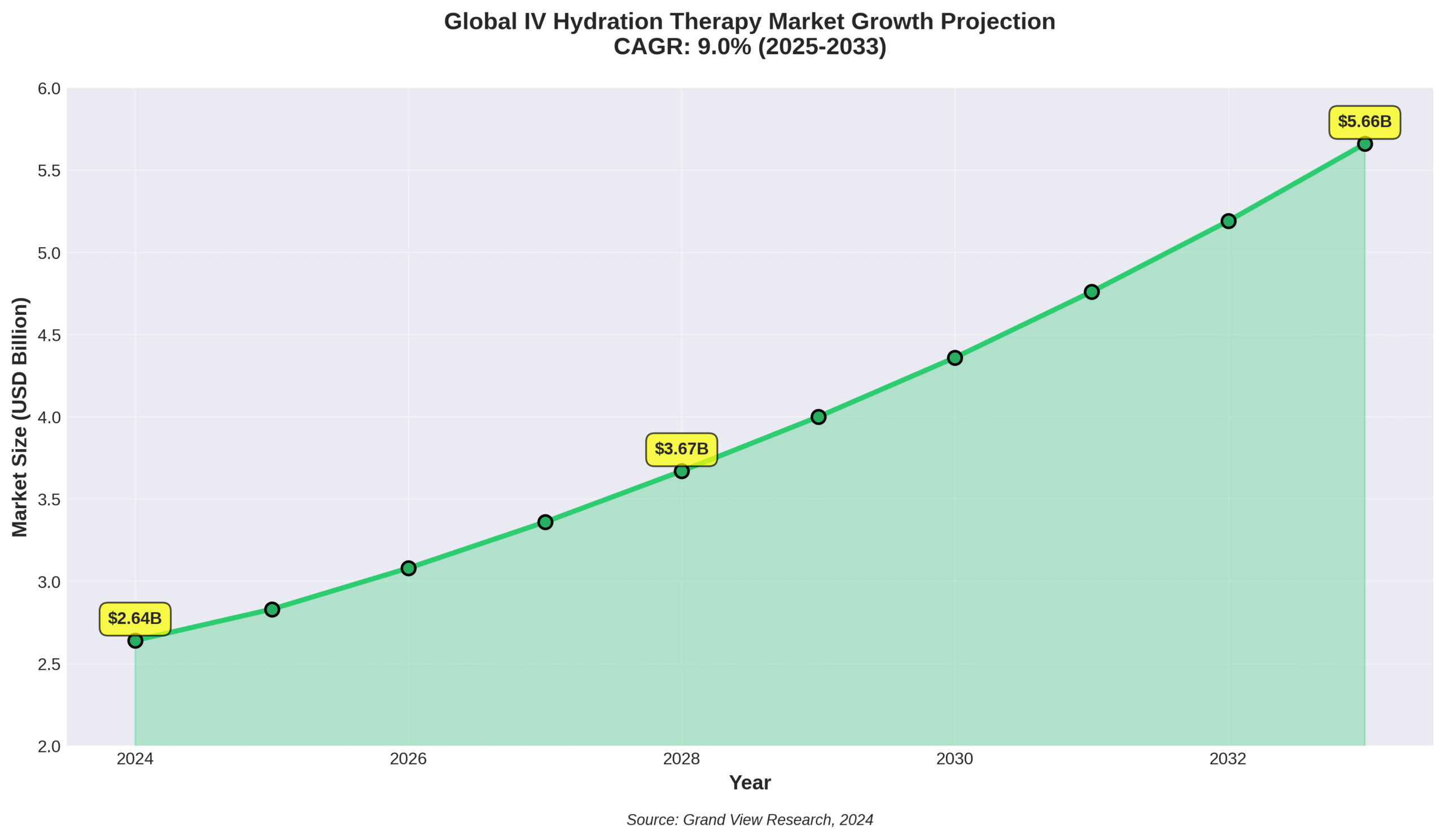
What Is IV Therapy and How Does It Work for Energy?
IV therapy is the direct administration of vitamins, minerals, and fluids into the bloodstream through an intravenous drip. This method bypasses the digestive system entirely, achieving 100% bioavailability compared to oral supplements’ 35% absorption rate. The energy-boosting effects occur through rapid delivery of B-complex vitamins, magnesium, and vitamin C directly to cells. The following subsections explore the specific ingredients, delivery mechanisms, and ideal candidates for energy IV therapy.
What Are the Main Ingredients in IV Energy Infusions?
The main ingredients in IV energy infusions are vitamin C, B-complex vitamins, magnesium, calcium, and specialized compounds like NAD+ and glutathione. Myers’ Cocktail contains 2,500 mg vitamin C, 1,000 mg magnesium chloride, 300 mg calcium gluconate, 1,000 μg vitamin B12, 100 mg vitamin B6, 250 mg vitamin B5, and B-complex vitamins totaling 200 mg in 37 mL solution.
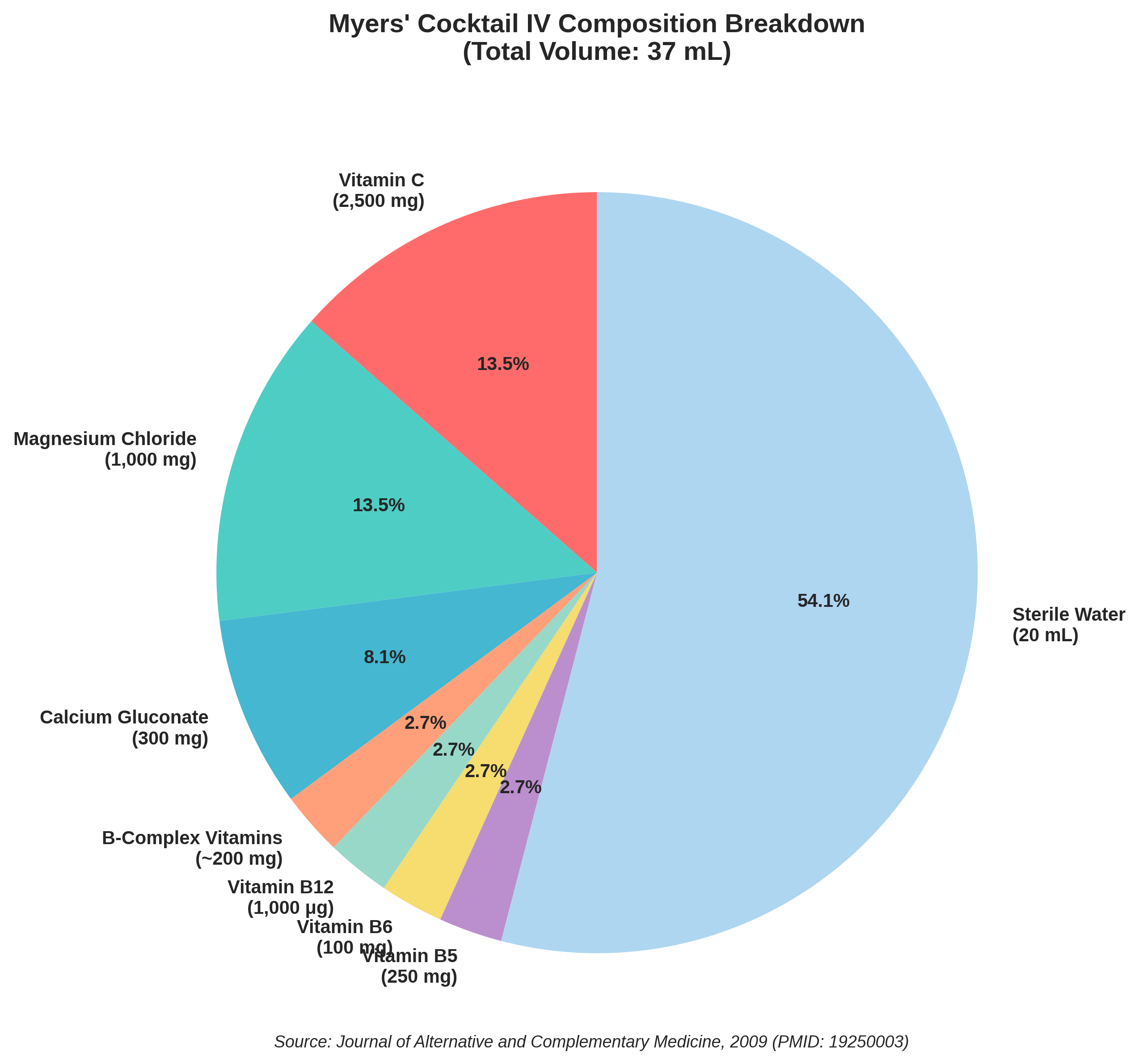
High-dose vitamin C ranges from 25-50 grams for enhanced immune function. B-complex vitamins and magnesium facilitate muscle recovery and boost energy metabolism. Glutathione provides antioxidant support for detoxification and reduced oxidative stress. NAD+ improves cognitive function and mental clarity. These ingredients work synergistically to combat fatigue at the cellular level.
How Does IV Therapy Deliver Nutrients Compared to Oral Supplements?
IV therapy delivers nutrients with virtually 100% bioavailability directly into systemic circulation, while oral supplements face significant GI tract absorption barriers. Oral vitamin C absorption is limited to approximately 1 gram due to intestinal transporter capacity. IV-administered vitamin C achieves plasma levels up to 100 times higher than oral administration.
A 2024 study showed plasma vitamin C levels 2 hours after 10g IV intervention reached 267.90 ± 141.83 μg/ml compared to negligible increases from oral doses. IV administration bypasses first-pass liver metabolism, gastric acidity, digestive enzymes, and gut microbiota variations. This direct delivery method can achieve 70-fold higher blood levels compared to the highest tolerated oral dose.
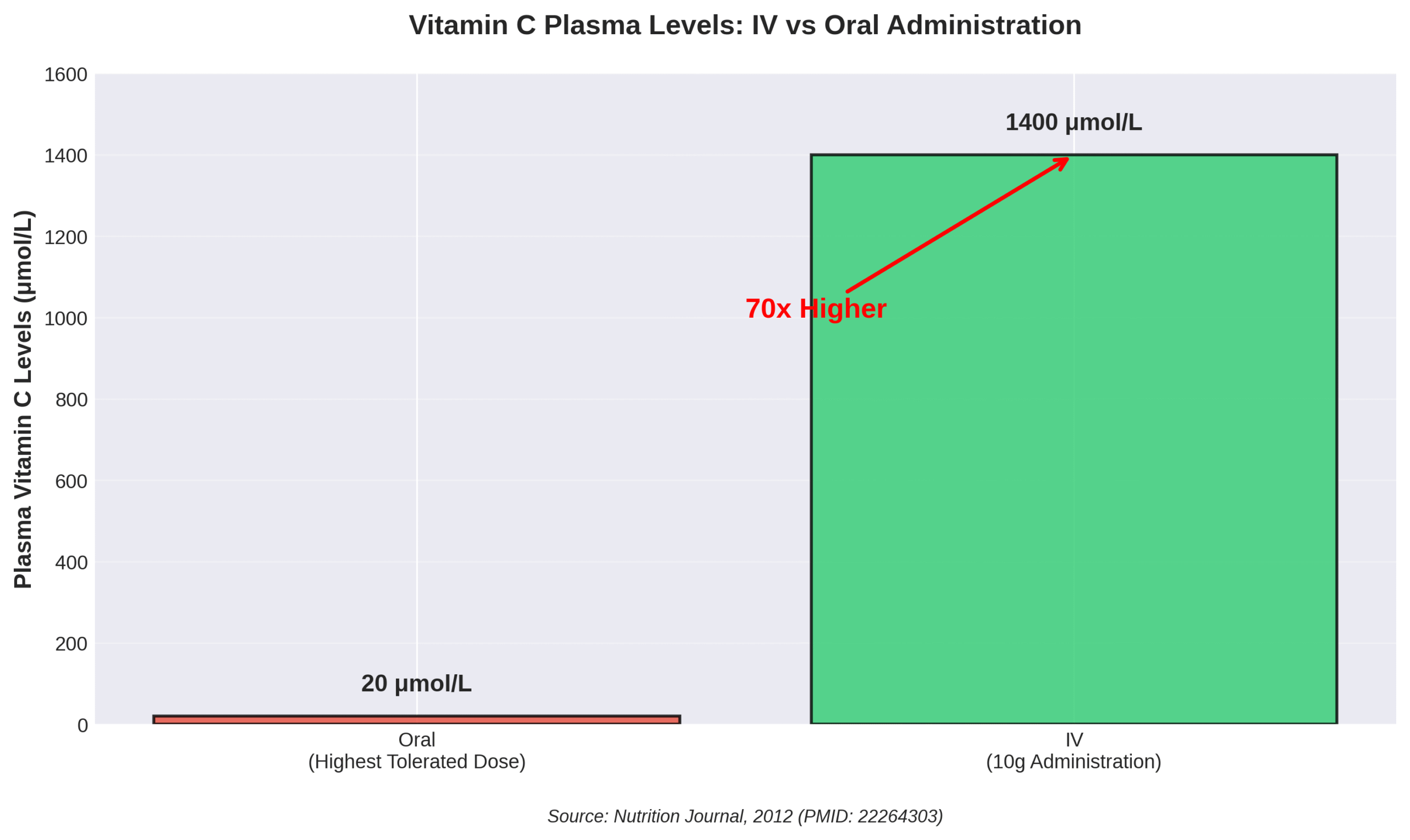
Who Can Benefit Most from Energy IV Therapy?
The people who can benefit most from energy IV therapy are those with chronic fatigue, fibromyalgia, athletes, office workers with fatigue, terminal cancer patients, and individuals with compromised immunity. A 2024 fibromyalgia study showed patients experienced significantly improved tender points, pain, depression, and quality of life after 8 weeks of weekly Myers’ Cocktail infusions.
Office workers showed significantly reduced fatigue scores 2 hours after 10g vitamin C IV intervention, with effects lasting one day. Athletes benefit from B-complex vitamins and magnesium for muscle recovery and energy metabolism. Terminal cancer patients in Korean studies showed improved fatigue with 10g vitamin C injections twice weekly. These targeted populations experience measurable improvements in energy and well-being through IV therapy’s rapid nutrient delivery system, preparing readers to understand the underlying causes of fatigue that IV therapy addresses.
What Causes Low Energy and Fatigue That IV Therapy Can Address?
Low energy and fatigue stem from multiple physiological imbalances that IV therapy targets through direct nutrient delivery. Dehydration, vitamin deficiencies, and chronic conditions create energy deficits that oral supplementation cannot rapidly correct. The following causes respond particularly well to IV intervention due to immediate systemic availability of fluids and nutrients.
How Do Hydration Levels Impact Energy?
Dehydration is a primary cause of fatigue that IV therapy directly addresses through rapid fluid replacement. IV hydration achieves 100% bioavailability of fluids compared to oral hydration which must pass through the digestive system.
According to 2024 market data, the global IV hydration therapy market reached USD 2.64 billion, with the energy boosters segment holding 25.29% market share. Cellular energy production requires adequate hydration for metabolic processes. IV fluids restore blood volume and cellular hydration within minutes rather than hours.
Can Vitamin Deficiencies Lead to Low Energy?
Vitamin deficiencies lead to low energy through impaired cellular metabolism and oxygen transport. Vitamin B12 deficiency causes fatigue, with IV administration of 1,000 μg providing immediate systemic availability. Magnesium deficiency affects ATP production, corrected through IV delivery of 1,000 mg magnesium chloride.
A clinical study on IV vitamin C found subjects with initially lower vitamin C levels showed more significant fatigue reduction compared to those with higher baseline levels. B-complex deficiencies impair mitochondrial function, addressed through IV delivery of thiamine (100 mg), riboflavin (2 mg), pyridoxine (2 mg), panthenol (2 mg), and niacinamide (100 mg).
How Can IV Therapy Help With Chronic Fatigue or Jet Lag?
IV therapy helps with chronic fatigue and jet lag through targeted nutrient replenishment and hydration. Non-comparative trials demonstrated regular vitamin C infusion reduced fatigue in chronic fatigue syndrome inpatients.
Chronic fatigue syndrome patients typically receive weekly IV therapy for several weeks combined with lifestyle modifications. Myers’ Cocktail delivers synergistic therapeutic effects from multiple vitamins and minerals specifically for chronic fatigue. The initial protocol involves weekly treatments for 3-4 weeks followed by maintenance infusions every 2-4 weeks. These protocols address the underlying nutritional deficits and oxidative stress that perpetuate chronic fatigue conditions.
What Are the Benefits of IV Therapy for Boosting Energy?
The benefits of IV therapy for boosting energy include rapid fatigue reduction, enhanced wellness, and improved mental focus. Clinical studies demonstrate that IV vitamin C reduces fatigue scores within 2 hours, with effects lasting up to one day.
A 2022 study on office workers found significant fatigue reduction after 10g vitamin C IV intervention, with plasma levels reaching 267.90 ± 141.83 μg/ml. Beyond energy enhancement, IV therapy delivers comprehensive wellness improvements through direct nutrient delivery that bypasses digestive limitations.
How Quickly Can You Feel Results from an IV Energy Drip?
Results from an IV energy drip can be felt within 2 hours of administration. Studies show fatigue scores decrease significantly after this timeframe and remain lower for one day. The pharmacological effect of vitamin C lasts 4-6 hours, with documented effectiveness at both 2 hours and 24 hours post-intervention.
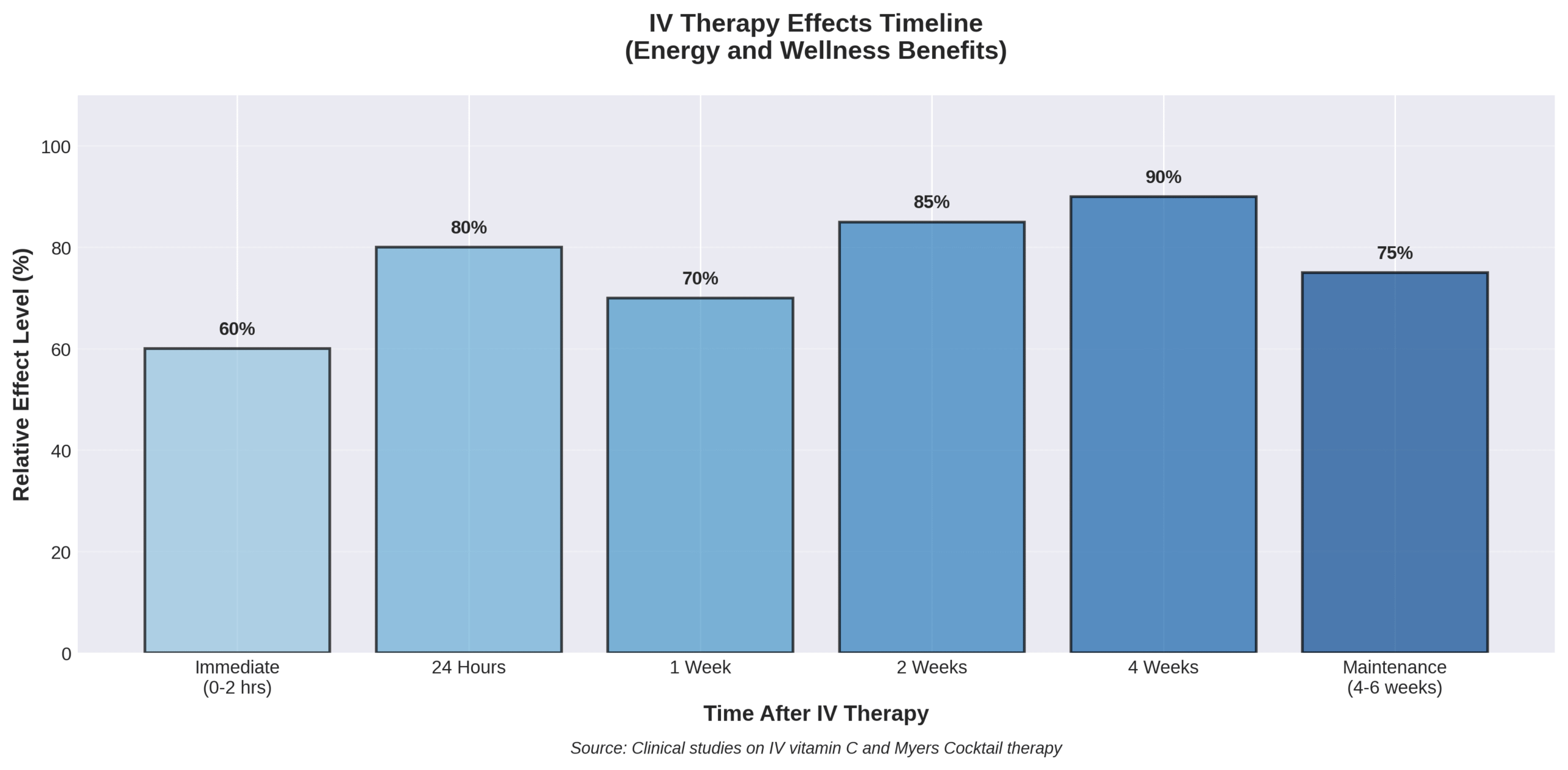
Many recipients report immediate energy boosts within 24-48 hours after treatment. Beneficial effects become more consistent after approximately 4 injections according to established treatment protocols. Mental clarity and overall well-being improvements occur within hours of administration.
Are There Additional Wellness Benefits Beyond Increased Energy?
Additional wellness benefits beyond increased energy include improved global health status, enhanced immune function, and reduced oxidative stress. A 2020 study showed advanced cancer patients experienced a 35.6% increase in global health status after 4 weeks of IV vitamin C therapy.
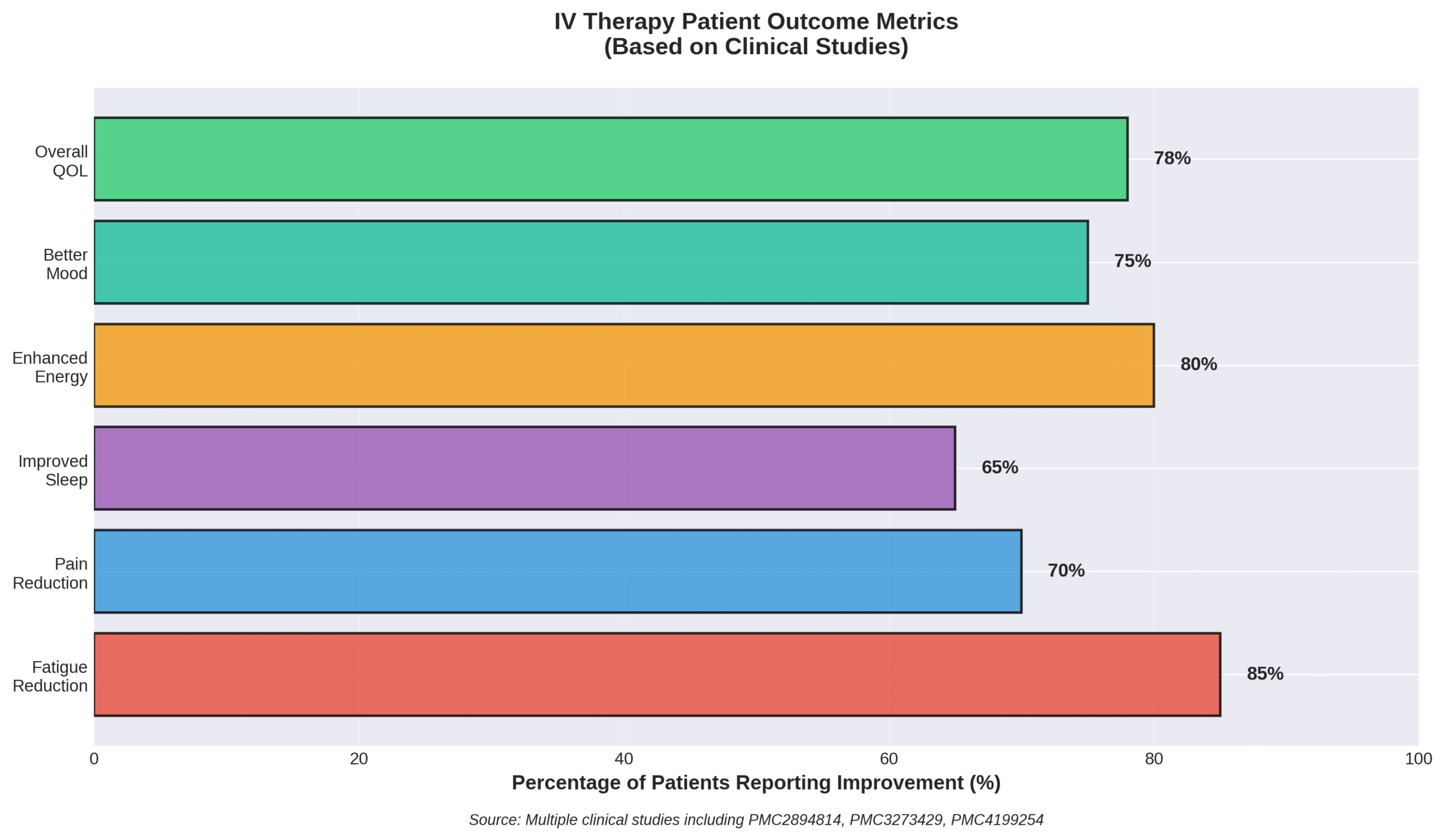
Fibromyalgia patients demonstrated improvements in physical, role, emotional, and social function after 2 weeks of Myers’ Cocktail therapy. IV therapy provides enhanced immune function through combinations of vitamin C, zinc, and glutathione. Glutathione and alpha-lipoic acid administration reduces oxidative stress and inflammation. After 4 weeks of IV vitamin C, cancer patients showed dramatic decreases in fatigue, pain, appetite loss, nausea, and insomnia.
Can IV Therapy Help Improve Mental Focus and Recovery?
IV therapy can help improve mental focus and recovery through targeted nutrient delivery. Vitamin B12, NAD+, and magnesium in IV formulations specifically enhance cognitive function and mental clarity. A 2018 fibromyalgia study showed cognitive functioning improvement after 4 weeks of Myers’ Cocktail therapy.
An 81-year-old male with pulmonary angiosarcoma experienced 50% reduction in total fatigue, including physical, emotional, and mental components. Athletes receiving weekly or bi-weekly IV sessions maintain optimum performance and recovery rates. Office workers demonstrated lower oxidative stress compared to placebo after vitamin C IV therapy, supporting mental clarity through reduced cellular stress.
What Are the Risks, Side Effects, and Safety Considerations for IV Energy Therapy?
The risks, side effects, and safety considerations for IV energy therapy include contraindications for certain medical conditions, potential adverse reactions at the injection site, and the necessity for qualified medical oversight. IV therapy requires careful patient screening and proper administration protocols to ensure safety.
Is IV Therapy for Energy Safe for Everyone?
IV therapy for energy is not safe for everyone, particularly individuals with kidney disease or heart disease who shouldn’t receive IV fluids unless prescribed by their doctor. The FDA has not approved IV vitamin C therapy as treatment for cancer side effects. Boutique IV therapy establishments are not FDA-approved and lack federal regulation.
A 2022 controlled study at Seoul National University Hospital on IV vitamin C found high-dose intravenous vitamin C proved to be safe and effective against fatigue. Administration must be performed by qualified, licensed healthcare professionals with rigorous adherence to sterility protocols.
Medical contraindications exist for several populations. Patients with renal dysfunction face risks from fluid overload and electrolyte imbalances. Cardiac patients require specialized monitoring during infusions. The lack of FDA oversight for boutique establishments creates additional safety concerns.
What Are Common Side Effects or Contraindications?
Common side effects of IV energy therapy are pain at the IV site, swelling at the IV site, scarring at the IV site, and infection risk if sterile techniques aren’t followed. Serious complications from improper administration include blood clotting, inflammation, bloodstream infection, and electrolyte imbalance.
Potential toxicity exists from excessive fat-soluble vitamins with repeated sessions. There are four fat-soluble vitamins that accumulate in body tissues: vitamin A, vitamin D, vitamin E, and vitamin K. Allergic reactions range from mild responses to severe anaphylaxis.
A 2012 randomized controlled trial at Yale University on fibromyalgia treatment with Myers’ Cocktail reported a single minor adverse event in one subject among 38 participants (n=38). Individuals taking medications face serious drug interaction risks. Beta-blockers, diuretics, and anticoagulants require particular caution.
How Should You Prepare for an IV Therapy Session?
Preparation for an IV therapy session requires patient screening to identify contraindications before treatment. Medical oversight remains essential with treatment performed in medical-grade facilities. Safety guidelines establish maximum frequency at 2 times per week for most people.
Individual assessment determines appropriate frequency based on severity of condition and individual needs. Reputable facilities with strict protocols ensure safe administration. Pre-treatment screening includes:
• Medical history review for chronic conditions
• Current medication assessment for interactions
• Allergy testing for vitamin sensitivities
• Baseline vital sign measurements
• Hydration status evaluation
Patients should arrive well-hydrated and inform providers about recent illnesses or surgeries. Written consent documents outline potential risks and benefits. Post-treatment monitoring continues for 15-30 minutes to observe for adverse reactions. These safety measures help ensure IV energy therapy delivers benefits while minimizing risks for each individual patient.
How Does IV Therapy for Energy Compare to Other Methods?
IV therapy for energy delivers nutrients directly into the bloodstream, achieving 100% bioavailability compared to oral methods that face absorption limitations. The comparison between IV therapy and traditional energy-boosting methods reveals distinct advantages in bioavailability, speed of results, and therapeutic concentrations, though cost and accessibility remain important considerations. Understanding these differences helps determine when IV therapy offers superior benefits over oral supplements and energy drinks.
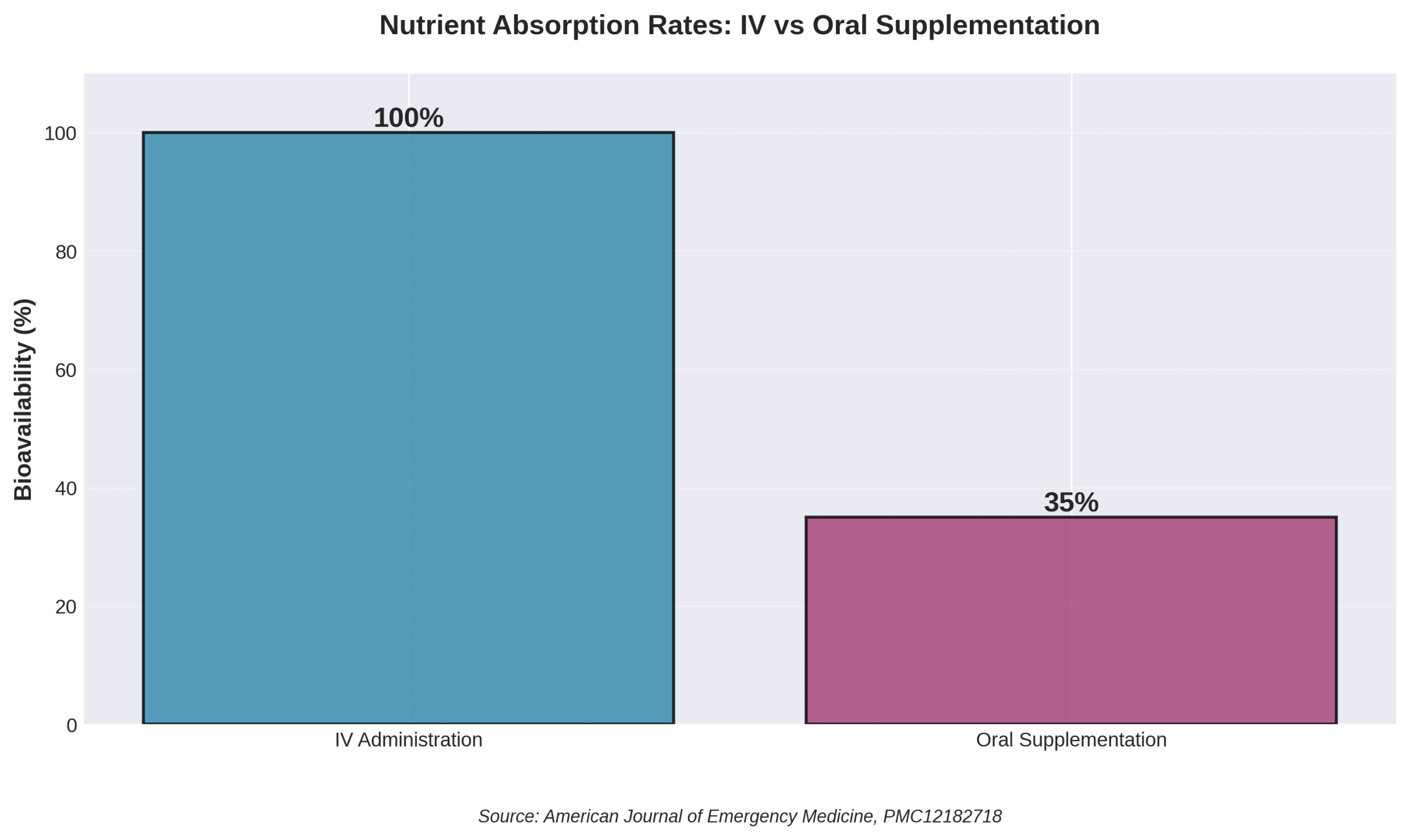
How Does IV Therapy Stack Up Against Energy Drinks and Supplements?
IV therapy achieves nearly 3x higher bioavailability at 100% compared to oral supplementation at 35%. Energy drinks and oral supplements encounter intestinal transporter capacity limits that restrict absorption, while IV administration bypasses these biological barriers entirely. The cost difference is substantial—IV therapy ranges from $100 to over $300 per session versus the much lower cost of oral supplements and energy drinks.
Health insurance rarely covers IV therapy sessions, making them entirely out-of-pocket expenses. Energy drinks provide immediate but short-lived stimulation through caffeine and sugar, while IV therapy delivers sustained nutrient replenishment directly to cells. The direct systemic delivery of IV therapy eliminates the variability in absorption rates that affects oral supplements due to factors such as digestive health, meal timing, and individual metabolism.
Is IV Therapy More Effective Than Oral Vitamins for Energy?
IV therapy is more effective than oral vitamins for achieving therapeutic nutrient concentrations. Randomized controlled trials with oral vitamin C showed negative results for fatigue reduction, while IV administration demonstrated positive outcomes. Oral vitamin C plasma concentrations plateau regardless of dose increases due to intestinal absorption limits, while IV administration bypasses these physiological controls entirely.
IV therapy achieves therapeutic concentrations unattainable through oral administration—up to 70-fold higher blood levels compared to the highest tolerated oral doses. Oral delivery faces tight regulation through intestinal absorption, tissue transport, renal reabsorption, and excretion mechanisms that IV therapy circumvents. High oral doses of vitamin C cause osmotic diarrhea and gastrointestinal discomfort, while IV administration avoids these digestive side effects completely.
When Is IV Therapy Preferable Over Other Energy-Boosting Options?
IV therapy is preferable when immediate results are needed, as effects occur within 2 hours versus the delayed absorption of oral methods. Chronic conditions such as fibromyalgia and chronic fatigue syndrome show better response to IV therapy than oral supplementation according to clinical studies. Compromised GI absorption due to illness, surgery, or digestive disorders makes IV therapy necessary for adequate nutrient delivery.
Athletes during training periods benefit from weekly IV treatments for enhanced performance and accelerated recovery. According to Dr. Joshua Septimus, “If you’re healthy, do you need to get your hydration, vitamins and other nutrients from an IV? The answer is a resounding, ‘No.'” This expert opinion emphasizes that IV therapy serves specific therapeutic needs rather than general wellness for healthy individuals. The direct comparison reveals IV therapy excels for acute needs, chronic conditions, and situations where oral absorption is compromised.
What Should You Expect During and After an IV Energy Therapy Session?
IV energy therapy sessions follow predictable patterns from preparation through recovery. Understanding the timeline, sensations, and treatment frequency helps set realistic expectations for your energy enhancement journey.
How Long Does a Typical IV Energy Infusion Take?
A typical IV energy infusion takes 20-60 minutes for standard formulations. Myers’ Cocktail, the most common energy blend, requires approximately 10 minutes when administered via slow-push infusion. High-dose vitamin C infusions containing 5-25 grams extend treatment time to 30-120 minutes based on dosage levels.
The procedure uses a 25-gauge butterfly needle inserted into the antecubital fossa. Myers’ Cocktail solution appears bright yellow due to its B-vitamin concentration. Treatment duration varies by infusion rate and total volume administered.
What Does the Procedure Feel Like?
The procedure feels like a brief pinch during needle insertion at the IV site. Most patients read, use devices, or relax throughout the infusion without significant discomfort. Some patients experience warmth or flushing sensations during vitamin administration, particularly with B-complex vitamins.
Myers’ Cocktail uses slow-push delivery to minimize discomfort. Mild pain at the IV site occurs occasionally but remains tolerable for most patients. The infusion process itself typically feels unremarkable beyond initial needle placement.
How Many Sessions Are Usually Needed for Lasting Results?
The initial phase requires once per week sessions for 3-4 weeks. Noticeable effects typically emerge by the fourth Myers’ Cocktail treatment. Maintenance involves treatments every 4-6 weeks following the initial series.
Chronic fatigue syndrome demands once weekly sessions for several weeks combined with lifestyle modifications. Athletes require weekly or bi-weekly sessions during training periods for optimal performance. Standard wellness maintenance ranges from once every 2 weeks to once monthly based on individual response and energy goals.
These treatment protocols establish consistent nutrient levels while allowing your body to maintain enhanced energy between sessions.
How Should You Approach IV Therapy for Energy With The Drip IV Infusion?
The Drip IV Infusion approaches energy IV therapy through personalized treatment protocols that consider individual health needs, baseline nutrient levels, and specific energy goals. The clinic’s methodology involves comprehensive patient assessment followed by customized nutrient formulations delivered through medical-grade IV infusions. The following subsections explore how The Drip IV Infusion tailors treatments and what patients should understand about IV therapy for energy enhancement.
Can The Drip IV Infusion Customize Energy IV Treatments for Individual Needs?
The Drip IV Infusion customizes energy IV treatments by adjusting nutrient concentrations based on individual assessment results and specific health conditions. Myers’ Cocktail preparation costs approximately $18 USD per dose and allows modification of vitamin and mineral concentrations to match patient requirements. Individual assessment at The Drip IV Infusion determines treatment frequency, which ranges from weekly sessions for athletes to monthly maintenance for general wellness needs.
Energy IV formulations contain tailored combinations of B-complex vitamins, vitamin C, and magnesium. There are multiple customization options available, such as adding NAD+ for cognitive enhancement, glutathione for detoxification, or higher vitamin C doses for immune support. Treatment protocols vary based on patient goals—athletes receive weekly or bi-weekly sessions during training periods while office workers may need monthly maintenance infusions.
Baseline vitamin levels guide customization decisions since patients with lower initial levels show greater benefit from IV therapy. The Drip IV Infusion considers these baseline measurements when determining optimal nutrient concentrations and session frequency. This personalized approach ensures each patient receives the specific nutrients needed to address their unique energy deficits and health goals while maintaining safety protocols throughout the customization process.
What Are the Key Takeaways About Using IV Therapy for Energy?
IV therapy for energy achieves 100% bioavailability compared to 35% for oral supplements, with effects noticeable within 2 hours of treatment. North America dominated the IV therapy market with 46.8% share in 2024, with projections reaching USD 5.66 billion globally by 2033. These statistics reflect growing recognition of IV therapy’s effectiveness for energy enhancement.
Clinical studies demonstrate significant fatigue reduction lasting 1 day after single treatment and sustained improvements following 4-week protocols. A 2024 study showed office workers experienced reduced fatigue scores 2 hours after 10g vitamin C IV intervention (p = 0.004). Safety requires administration by licensed healthcare professionals with medical oversight and thorough patient screening before treatment.
Evidence for healthy individuals remains primarily anecdotal with no FDA approval for boutique IV therapy companies. Cost ranges from $100 to over $300 per session and health insurance rarely covers these treatments. The Drip IV Infusion addresses these considerations through transparent pricing, qualified medical staff, and evidence-based treatment protocols that prioritize patient safety while delivering measurable energy improvements for those experiencing fatigue or seeking performance enhancement.
